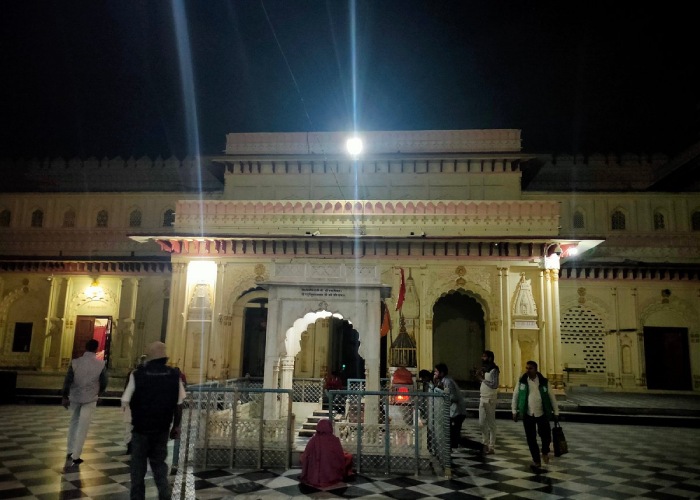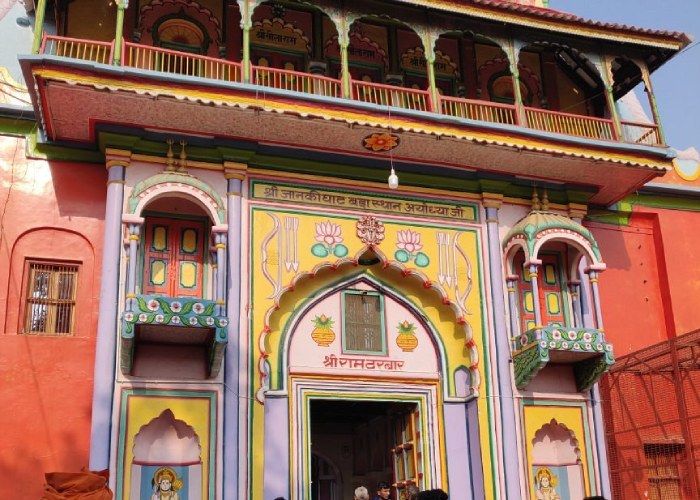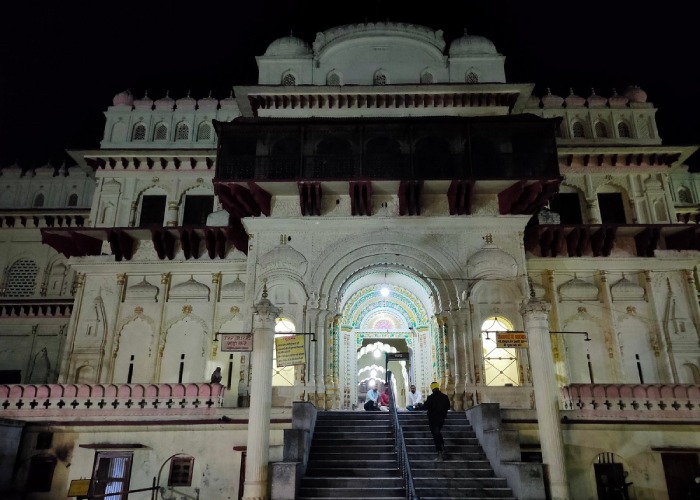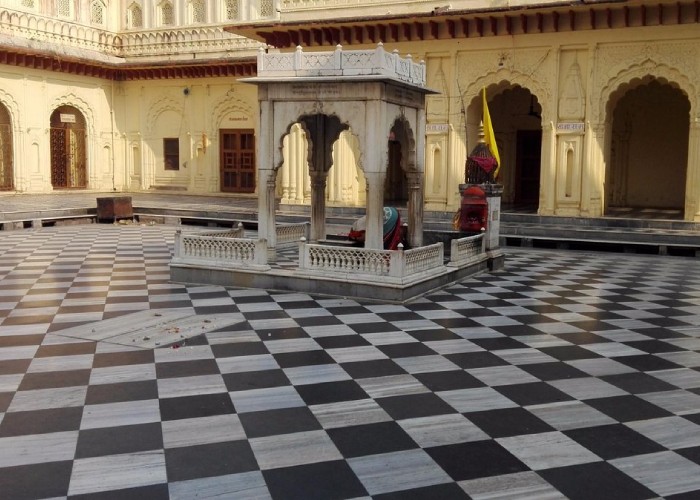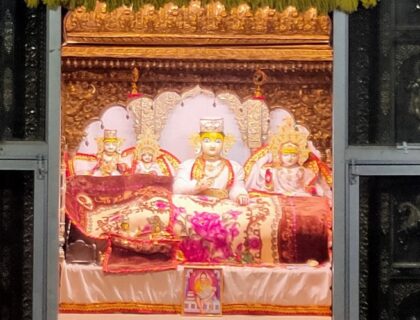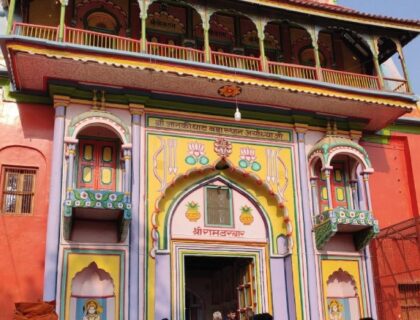Kanak Bhawan Temple Ayodhya
Kanak Bhawan Temple also known as Golden Temple is a temple in Ram Janmabhoomi, Ayodhya, located northeast of Ramkot in Uttar Pradesh. It is one of the most famous temples in Ayodhya. It is believed that Kaikeyi gifted this palace (temple) to Rama and Sita immediately after their marriage, making it their palace.
According to legend, after the original Kanak Bhawan was damaged, lord Krishna himself rebuilt it during the Dvapar Yuga. It is believed that Vikramaditya renovated it during the mediaeval period. Queen Vrishabhanu Kunwari later renovated it, and it can still be seen today. The main idols in the sanctum sanctorum are Rama and Sita. The temple has a magnificent structure, and many pilgrims travel from all over the country each year to make offerings to the deities.
Legend of Kanak Bhawan Temple Ayodhya
According to legends, the Kanak Bhawan Temple was designed as a massive palace. This temple’s architecture is similar to Rajasthani and Bundelkhandi palaces. According to history, this palace was gifted to Goddess Sita as a wedding gift from Lord Ram’s Stepmother Kaikeyi. It gradually deteriorated and was eventually destroyed during the Lodhi and Tughlak Eras. It has been rebuilt and renovated several times over its history.

Rama’s son Kush completed the first reconstruction during the early Dvapara Yuga. Following this, it was rebuilt by King Rishabh Dev (Tirthankara) in the middle of the Dvapara Yuga, and Shri Krishna is thought to have visited this ancient site in the pre-Kali Yuga period (around 614 BC).
History of Kanak Bhawan Temple Ayodhya
In the present era, it was built by Chandragupta-II of the Gupta Empire during the Yudhishthira period in 2431 BC. Following that, Samudragupta completed it in 387 AD. In 1027 AD, Nawab Salarjung-II Ghazi destroyed the temple, which was later renovated in 1891 by Bundela Rajput Maharaj of Orchha and Tikamgarh of Bundelkhand, Maharaj Mahendra Pratap Singh, and his wife Maharani Vrishabhan Kunwari. This construction was finished on the Shaishthi of Vaishakh Shukla in Guru Paush.

The architecture of Kanak Bhawan Temple Ayodhya
There are three pairs of idols here, all of which depict Rama and Sita together. Maharani Vrishabhan Kunwari installed the largest statue. It is believed that she was the driving force behind the temple’s reconstruction and establishment. King Vikramaditya has installed a statue of a somewhat lower height on the right side of this pair. He kept this idol safe when the ancient temple was attacked. The third and smallest pair is said to have been given by Shri Krishna to a female devotee worshipping Rama at this location.
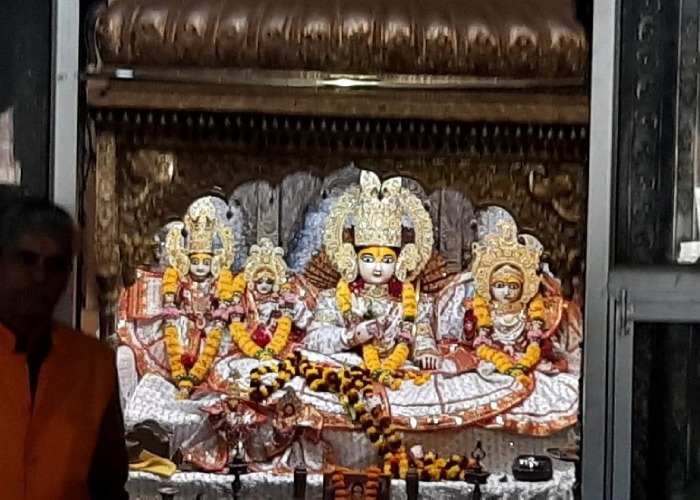
Shri Krishna instructed the woman to bury these idols with her after her death because this location would later be designated as a holy site, and a great king would build a massive temple there during the Kali Yuga. Later, when Maharaj Vikramaditya oversaw the construction of this temple and excavated the base, he discovered these ancient idols. During the construction of the current temple, all three pairs were housed in the sanctum sanctorum. Now we can see all three pairs.

This shrine is a magnificent example of temple architecture and design, and it is the most beautiful and appealing structure in Ayodhya. Its magnificence and charm are not limited to its exterior façade; the deities installed in the sanctum are so beautiful and captivating to behold that one is left dumbfounded and spellbound upon seeing them. When the rays of the rising and setting sun fall on the building, it looks fantastic and provides a captivating view.
Facts about Kanak Bhawan Temple Ayodhya
- Kanak Bhawan Temple is a Hindu temple in Ayodhya’s Tulsi Nagar area, about 2 kilometres from Ayodhya Junction.
- It is located northeast of Ram Janam Bhoomi or Ramkot and is one of the most popular temples to visit in Ayodhya as part of your Uttar Pradesh tour.
- The Kanak Bhawan Temple is dedicated to Lord Ram and his divine consort Sita. It is believed that Kaikei gave this building to Devi Sita shortly after her marriage to Lord Rama.
- This is Devi Sita and Lord Rama’s private palace. Vikramaditya had it renovated, and Vrish Bhanu Kunwari completely rebuilt it in 1891.
- This shrine is a stunning example of Bundelkhand architecture and the most beautiful structure in Ayodhya.
- The Kanak Bhawan Temple’s central hall has arched doorways on three sides, and the sanctum sanctorum contains three pairs of gold-crowned idols of Lord Rama and Goddess Sita.
- The largest pair was installed by Rani Vrish Bhanu Kunwari. The pair to its right is of medium height and is said to have been established by King Vikramaditya, while the third pair is the smallest and is traditionally believed to have been given by Lord Krishna to a female hermit who was meditating on Lord Ram at this location.
- All of these idols are beautifully decorated with heavy gold ornaments, which is why the temple is known as Kanak Bhawan, which translates to “golden house.”
- Aside from its religious significance, Kanak Bhawan serves as an important cultural centre in Ayodhya. Various cultural programmes, such as dance, music, and Ramayana discourses, are held on the temple grounds, particularly during festivals.
Famous Festivals In Kanak Bhawan Temple Ayodhya
- Holi – This festival is celebrated in the month of Phalgun (Feb – March). During the celebration, people celebrate with colours and enjoy the temple complex.
- Ram Navmi – Rama Navami is a Hindu festival that celebrates the birth of Rama, one the most popularly revered deities in Hinduism, also known as the seventh avatar of Vishnu.
- Diwali – Diwali is the festival of lights with its variations also celebrated in other Indian religions. It symbolises the spiritual “victory of light over darkness, good over evil, and knowledge over ignorance”.
Best Time to Visit Kanak Bhawan Temple Ayodhya
This place is very heavenly and spiritual, and you can visit it all year. However, the best time to visit this temple is during the monsoon and winter seasons. During the monsoon season, this location receives moderate to heavy rainfall, making it appear heavenly with its greenery and bringing freshness elsewhere.
How to Reach Kanak Bhawan Temple Ayodhya
The best time to visit the Kanak Bhawan Temple is between September and February, and during RamNavmi which is celebrated grandly here.
By Air: Lucknow International Airport is the nearest airport, located 152 kilometres from Ayodhya. Ayodhya is approximately 158 km from Gorakhpur Airport, 172 km from Prayagraj Airport, and 224 km from Varanasi Airport.
By Rail: Ayodhya Cantt and Ayodhya are the district’s major railway stations, with connections to almost every major city and town. By rail, Ayodhya is 128 kilometres from Lucknow, 171 kilometres from Gorakhpur, 157 kilometres from Prayagraj, and 196 kilometres from Varanasi.
By Road: Uttar Pradesh Transport Corporation buses operate 24 hours a day and are easily accessible from all locations. By Road: Faizabad is 152 kilometres from Lucknow, 158 kilometres from Gorakhpur, 172 kilometres from Prayagraj, and 224 kilometres from Varanasi.
Also Read – Sri Kalaram Temple Nashik
Support Us
If our content helps you even 1% in gaining information about the temple, please support us by contributing any amount, our UPI ID is - q417999792@ybl Or pay using QR CODE >>> Click Now
Location
Facilities
- Drinking Water
- Pooja Item Shops
- Prasad Shops
- Restaurants Nearby
- Resting Room




